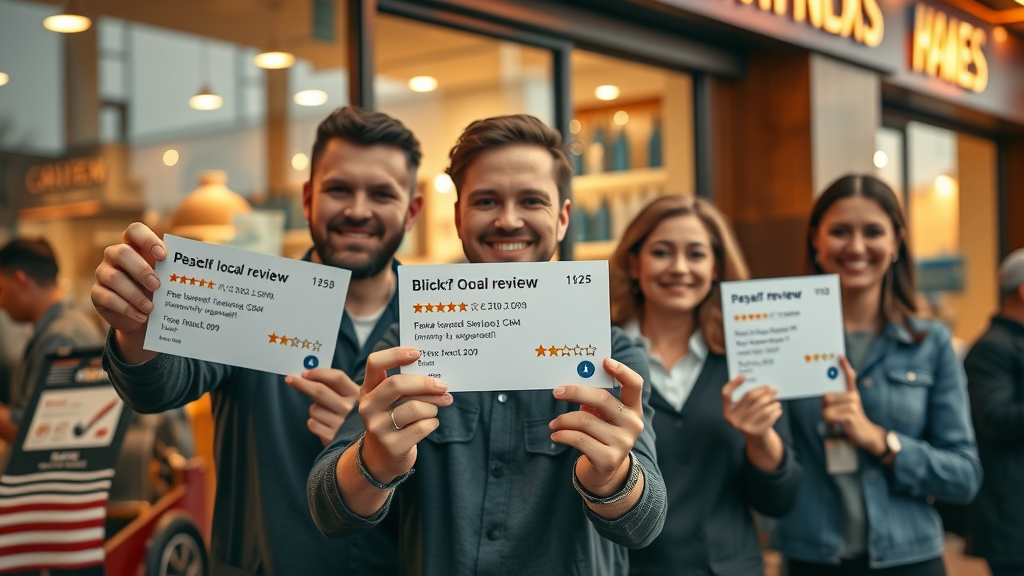Did you know? Studies show that 88% of local consumers trust online reviews as much as personal recommendations . That means your brand reputation is just as influential as word-of-mouth, becoming the cornerstone of local business success. In today’s digital-first world, one glowing review—or a single misstep—can shape the course of your brand’s future. Want to learn the secret to local business longevity? Read on to discover why brand reputation building is your most valuable business asset, how to master it, and which actionable strategies can propel your brand from good to unforgettable in your community.

Why Brand Reputation Building Sets the Pace for Local Success
Local businesses thrive when their communities trust and recognize them as reliable, authentic, and customer-focused. Brand reputation building isn’t just about managing your online presence; it’s an ongoing investment in every impression, every interaction, and every promise your business makes. For a local brand, reputation acts as a multiplier—boosting brand loyalty , powering word-of-mouth referrals, and enhancing your brand image throughout your target audience.
Let’s look at practical examples. When customers have positive experiences—whether in-store, online, or during customer service interactions—they are far more likely to leave favorable online reviews , recommend your business, and return themselves. On the other hand, ignoring feedback or delivering inconsistent service can result in a bad reputation that’s tough to shake. This is why building (and protecting) a strong brand reputation should be a top priority for every local business aiming for lasting success.
"Studies show that 88% of local consumers trust online reviews as much as personal recommendations—your brand reputation building strategy is your best business asset."
Essential Steps for Brand Reputation Building Excellence
- Define and communicate a strong brand identity
- Invest in customer service and customer experience
- Monitor feedback and practice proactive reputation management
- Leverage social media to amplify positive brand reputation
Defining Your Brand Identity for Positive Brand Reputation

Building a good brand reputation starts with a clear and authentic brand identity . This foundational step answers vital questions: What are your core values? Who is your target audience? What sets your products or services apart in the local marketplace? Defining these components allows every touchpoint—from visual branding to customer communications—to reflect your brand’s true personality.
Customers—and even employees—are drawn to brands with a consistent, transparent, and relatable identity. When your brand voice, messaging, and presentation are aligned, your business stands out on social media, review platforms, and even face-to-face interactions. By making your mission and messaging clear, you not only establish credibility but also build trust with your audience and lay the groundwork for strong brand loyalty .
Delivering Outstanding Customer Service and Customer Experience

A positive brand reputation grows from every interaction customers have with your business. Exceptional customer service and memorable customer experiences are non-negotiable for businesses aiming for distinction in a competitive marketplace. Prompt, empathetic responses to inquiries or complaints, seamless checkout processes, and thoughtful follow-ups foster satisfied, loyal customers who become your brand’s enthusiastic advocates.
Every customer interaction directly shapes your business’s public perception. One negative encounter can impact dozens of potential customers on social media platforms or online review sites. Conversely, consistently exceeding expectations turns everyday customers into loyal fans. Training your team to deliver uniform, high-quality service ensures your good brand reputation grows stronger with every experience.
Embracing Reputation Management: Turning Negative Feedback into Opportunities
Even the best-run businesses encounter negative feedback . What sets apart those with a strong brand reputation is their proactive response. Embracing reputation management means monitoring all channels—social media platforms, review sites, and direct feedback—so no concern goes unanswered. When a mistake occurs, fast, empathetic responses that seek to resolve the issue show your community that you value their opinions and are committed to improvement.
By viewing criticism as an opportunity, you can transform dissatisfied customers into lifelong loyal fans. Systematically collecting and acting on feedback ensures ongoing improvement and shows your commitment to customer satisfaction . Over time, your willingness to listen, adapt, and take responsibility builds a reputation for transparency and reliability that sets your brand apart.
Harnessing Social Media to Boost Good Brand Reputation

Social media platforms are powerhouses for brand visibility and engagement in the local market. Proactive management—responding to comments, sharing customer stories, and celebrating milestones—amplifies positive brand sentiment and extends your reach. A responsive, authentic presence reassures potential buyers and encourages satisfied customers to spread the word.
By crafting tailored content and engaging directly with your community, you position yourself as approachable and invested in your customers. This not only enhances your brand awareness but also demonstrates transparency, both of which are vital for sustaining a good brand reputation in today’s digital age.
The Pillars of Brand Reputation Management: Strategy and Structure

The Three Pillars Explained: Brand Identity, Customer Perception, and Ongoing Engagement
| Pillar | Description | Action Steps |
|---|---|---|
| Brand Identity | How your company is perceived | Create a mission statement, establish key messaging |
| Customer Perception | How customers truly see you | Solicit reviews, analyze feedback |
| Ongoing Engagement | How you maintain interaction | Regular posts, personalized outreach |
These pillars serve as the blueprint for effective brand reputation management . First, a clear brand identity ensures every action and communication is rooted in your core values, from marketing campaigns to face-to-face service. Second, by actively monitoring and shaping customer perception through review requests and transparent feedback processes, you keep your finger on the pulse of public sentiment.
Finally, consistent ongoing engagement—including personalized communications, events, and timely updates—demonstrates long-term commitment to your audience. Together, these three pillars create a positive feedback loop that cements lasting brand loyalty and growth.
Mastering Brand Awareness and Loyal Customer Relationships with Brand Reputation Building

Increasing brand awareness and nurturing loyal customers are natural byproducts of successful brand reputation building . When customers consistently enjoy positive experiences and resonate with your brand identity, they become vocal supporters across social media and in their personal networks. Over time, this cycle of positive interactions bolsters your good brand standing and ensures your place in the local market.
Loyal customer relationships are not built overnight—they require attention, empathy, and frequent recognition of customer achievements or milestones. By implementing robust loyalty programs, celebrating customer wins, and routinely gathering customer feedback for improvement, you reinforce brand loyalty and ensure your best customers become lifelong ambassadors for your business.
Guidelines for Building a Strong Brand Reputation in a Local Marketplace
Success in brand reputation building hinges on a few pivotal guidelines: stay consistent, communicate transparently, and prioritize genuine community connections. Choose messaging and actions that reflect authenticity and responsiveness. Celebrate local involvement, give back where possible, and make your commitment to local values and causes unmistakable.
Demonstrate reliability with clear return policies, consistent service, and accessible customer support. When challenges or crises arise, address them swiftly and sympathetically to reassure customers that your brand stands by its promises. Over time, these efforts ensure you build a strong brand reputation that endures the tests of evolving market trends and changing customer expectations.
What Is Brand Reputation? Understanding Its Value in Business
"Your brand reputation isn’t what you say about yourself. It’s what customers and your community say when you’re not in the room."
Brand reputation refers to the collective perception, trust, and esteem your business holds in the eyes of customers, competitors, and your wider community. A strong brand reputation is one of the most powerful assets a business can have: it opens doors to partnerships, attracts dedicated employees, and inspires loyal customers, all of which ultimately drive long-term success.
A positive reputation is continuously shaped by the experiences you deliver and the stories customers share. Each successful transaction, insightful piece of content, and resolved complaint contributes to your overall brand image and increases your credibility. Conversely, a single mismanaged interaction can quickly spiral into a bad reputation that deters new business. This is why understanding and investing in brand reputation management is critical for any company seeking lasting results.
Brand Reputation in Action: Real-World Examples

- Case Study: A local boutique implemented a proactive review solicitation campaign, accompanied by a streamlined customer service follow-up process. Within six months, their online reviews improved dramatically, leading to a 40% increase in foot traffic and customer retention.
- Customer Testimonials: "Every time I shop here, I feel like I’m more than just a customer. Their team remembers my preferences and always goes the extra mile to make my experience memorable. This is my go-to store because they truly value their customers!"— Jane, loyal local shopper
These examples demonstrate the power of a positive brand reputation . Real results arise when customers’ experiences align with your brand promise, reinforcing trust and spreading positive word of mouth across the community.
Proven Strategies for Positive Brand Reputation and Customer Loyalty

Consistency in Brand Messaging and Delivering on Promises
Consistency is at the heart of brand reputation building and brand reputation management . Whether through in-person service or your latest digital marketing campaign, your messaging and delivery must always align with expectations you set. Inconsistent or overpromising communications put your brand loyalty and brand image at risk.
To prevent disappointment and foster trust, always communicate transparently about your products or services , and never promise more than you can deliver. Honor commitments and make every effort to keep customers informed if challenges arise. This degree of reliability is what inspires loyal customers to return and recommend your business.
Innovative Customer Experience: Strengthening the Good Brand Standard

Innovative and adaptable customer experience approaches deliver more memorable interactions and reinforce your good brand reputation . Examples include implementing technology that streamlines checkout, personalized outreach using customer data, or introducing loyalty programs that reward engagement. Such strategies tap directly into evolving customer needs, proving your commitment to not just meeting but exceeding expectations.
Customers share both positive and negative stories about their interactions. By surprising your audience with thoughtful service or creative enhancements, your business stands out for the right reasons—fueling both brand awareness and customer loyalty.
Dealing with Negative Feedback: Turning Detractors Into Advocates
No brand is immune to criticism. The best businesses, however, manage negative feedback as an opportunity—not a setback. Immediate acknowledgment, a sincere apology, and a solution-oriented approach can turn a detractor into a lifelong champion. Respond to all feedback publicly and follow up privately if needed, demonstrating that every customer’s opinion matters.
Sharing positive resolutions on the same media platforms where criticism was received also demonstrates transparency. When potential customers see your willingness to handle mistakes gracefully, you actually enhance your positive reputation and increase your appeal over competitors who might ignore their critics.
People Also Ask
How do you build brand reputation?
Building brand reputation involves defining your brand identity , delivering consistently outstanding customer experiences , actively gathering and acting on customer feedback , and engaging authentically on social media platforms. Transparency and responding effectively to both positive and negative reviews are key to establishing trust and a strong brand reputation in your community.
What is an example of brand reputation?
A strong example of brand reputation can be seen in local businesses with a significant volume of positive online reviews and visible community involvement. For instance, a bakery that regularly engages with its customers on social media, responds graciously to feedback, and participates in neighborhood events often enjoys a good brand reputation that draws in loyal customers.
What is reputation building?
Reputation building is the ongoing process of shaping how your business is perceived by customers, stakeholders, and the community. It incorporates reputation management strategies like monitoring feedback, improving customer service , and communicating consistently to ensure a positive brand image and strong market presence.
How to master the 3 pillars of brand reputation management?
To master the three pillars of brand reputation management —Brand Identity, Customer Perception, and Ongoing Engagement—focus on clear messaging, actively solicit and act on feedback, and maintain open dialogue with your entire audience. Combining these focus areas results in long-term loyalty, a positive reputation , and ongoing growth.
FAQs About Brand Reputation Building
-
How does brand reputation building impact customer loyalty?
A sustained reputation-building effort nurtures customer loyalty by demonstrating that your brand values every customer relationship. When customers feel respected and heard, their trust deepens, and they return repeatedly—often recommending your business to friends and family.
-
Can social media make or break a brand reputation?
Yes—active and positive engagement on social media expands your brand awareness and credibility, while negative viral experiences or ignored feedback can harm your brand reputation . Consistency and responsiveness are essential to harnessing social media as a force for good.
-
What’s the role of customer service in brand reputation management?
Exceptional customer service is vital for reinforcing your brand reputation . Every positive interaction earns trust and can turn occasional customers into raving loyalists. Conversely, unresolved issues or poor service can quickly lead to a bad reputation .
-
How often should you ask for customer feedback?
Frequent feedback requests keep you ahead of problems and demonstrate your desire to improve. Regular follow-ups—after purchases or interactions—show customers their opinion is valued and helps prevent small issues from becoming major complaints.
Common Pitfalls and How to Avoid Brand Reputation Damage

- Ignoring online reviews
- Inconsistent responses on social media
- Failing to address negative feedback promptly
- Neglecting ongoing community engagement
These common mistakes can erode hard-earned trust and brand loyalty . Set regular alerts for new mentions, implement communication guidelines for your team, and commit to timely, empathetic responses in all interactions. Invest in regular training and encourage active listening throughout your organization to reinforce your brand reputation every day.
Actionable Local Brand Reputation Building Tactics for Sustained Success
- Monitor online mentions regularly
- Encourage positive reviews and testimonials
- Offer personalized experiences to loyal customers
- Provide fast, empathetic responses to complaints
- Engage with the community through events and partnerships
| Tactic | Description | Expected Impact |
|---|---|---|
| Review Monitoring | Watch local and industry review sites | Improve speed of addressing issues |
| Customer Thank Yous | Send follow-ups to loyal customer | Boosts retention and word-of-mouth |
| Live Events | Host or attend as a brand | Increases local brand awareness |
Implementing these tactics ensures your business remains top-of-mind for existing and prospective customers. By taking visible and frequent actions, you build trust, strengthen relationships, and create the kind of brand reputation that attracts loyal followers and sets you apart from competitors.
Key Takeaways from Brand Reputation Building for Local Businesses
- A strong brand reputation is built through consistency, transparency, and genuine connections
- Reputation management is an ongoing process that rewards proactive communication
- A positive brand reputation increases customer loyalty and business growth
Begin Your Brand Reputation Building Journey Now

Ready to take the next step? Start by evaluating your current brand reputation, setting clear identity standards, and implementing these actionable tactics. Every meaningful improvement brings your business closer to lasting local success—don’t wait to build the rewarding reputation your business deserves!
 Add Row
Add Row  Add
Add 




Write A Comment